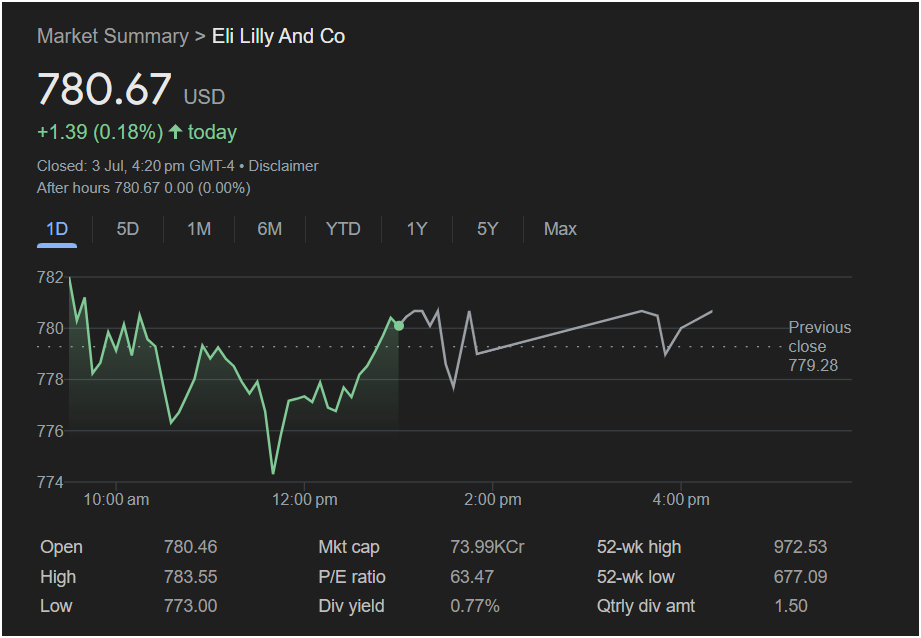Eli Lilly Stock Analysis: Resilience Signals Potential Upside After Volatile Session

Eli Lilly And Co. (LLY) stock ended Wednesday’s session with a modest gain, but the real story for traders lies in the dramatic intraday volatility and the stock’s powerful recovery from its lows. This display of resilience could be a key indicator for the stock’s direction heading into Monday’s trading.
For investors questioning whether to buy now, a deep dive into the session’s data reveals critical support and resistance levels that will likely dictate the next move.
Decoding Wednesday’s Turbulent Trading Day
Eli Lilly stock closed at
1.39 (0.18%). While the net change was small, the journey to that close was anything but. Here are the session’s vital statistics:
-
Open: $780.46
-
High: $783.55
-
Low: $773.00
-
Previous Close: $779.28
The stock opened just above its previous close but immediately faced selling pressure. What followed was a highly volatile morning session, culminating in a sharp dip to the day’s low of $773.00 around noon.
However, at this key level, buyers stepped in with force. The stock staged a powerful rebound throughout the afternoon, erasing all its losses and ultimately closing in positive territory. This type of intraday reversal, where a stock fills a deep morning gap down to close green, is often interpreted as a very bullish sign, indicating strong underlying demand. After-hours trading remained flat, holding the gains.
Essential Financial Metrics for Traders
To put the price action into context, here are the key fundamentals for Eli Lilly stock:
-
Market Cap: 73.99KCr (This regional format represents a massive market capitalization of approximately $885 Billion USD), making it one of the largest pharmaceutical companies in the world.
-
P/E Ratio: 63.47. This high price-to-earnings ratio signifies that investors have very strong expectations for future earnings growth, largely fueled by its popular drug pipeline.
-
52-Week Range: The stock has traded between
972.53. Its current price shows it’s well off its all-time high but still in a powerful long-term uptrend.
-
Dividend Yield: 0.77%, with a quarterly dividend of $1.50. The low yield is typical for a company prioritizing aggressive growth and reinvestment.
Will Eli Lilly Stock Go Up or Down on Monday?
The chart provides compelling clues for the next session.
The Bullish Case (Potential for an Upturn):
The bullish argument is strong. The defense of the $773.00 level was decisive. Buyers not only stopped the bleeding but were aggressive enough to push the stock to a positive close. This demonstrates significant underlying strength and suggests that dips are being actively bought. Traders will view the
783.55**.
The Bearish Case (Potential for a Downturn):
The primary concern for bears is the high volatility itself. Wild price swings indicate uncertainty, and the stock’s high P/E ratio makes it vulnerable to any negative news or shifts in market sentiment. While it recovered, the fact that it fell over
773.00** support level on a subsequent test would be a major bearish signal, potentially leading to a deeper correction.
for Investors:
Based on the evidence, the outlook for Eli Lilly stock leans bullish for Monday. The powerful intraday recovery is a testament to strong buyer interest. Is it the right time to invest? For aggressive traders, the bounce off a clear support level may present an attractive entry point.
Key levels for all traders to watch on Monday are:
-
Crucial Support: The intraday low of $773.00. As long as the stock remains above this level, the bulls are in control.
-
Primary Resistance: The intraday high of $783.55. A sustained move above this level could signal the start of the next leg up towards higher prices.
Given the stock’s volatile nature, a prudent strategy could be to wait for a break above resistance or a successful re-test of the support level before committing capital.
Disclaimer: This article is an analysis based on the provided image and is for informational purposes only. It is not financial advice. All stock market trading and investment activities involve risk. You should conduct your own research and consult with a qualified financial professional before making any investment decisions.





